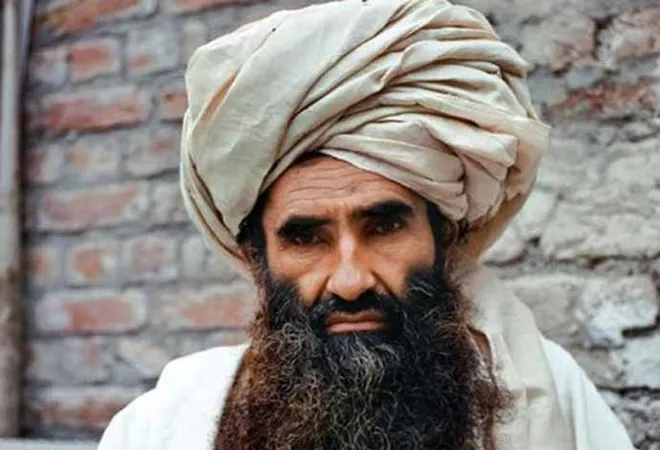-
CENTRES
Progammes & Centres
Location
It’s worrisome that even though Jalaluddin Haqqani, the leader of the Haqqani Network, is now dead, the infrastructure that he put in place is very much alive

Jalaluddin Haqqani, the 71-year-old Islamic militant, who first fought in the Soviet jihad in the 1908s and founded one of the world’s most notorious terror organisations, is now dead. His family-run transnational jihadiorganisation, known as the Haqqani Network, had provided support and sustenance to the groups such as Al Qaeda, Taliban and Lashkar-e-Tayyeba for decades.
Born in the Paktia Province of Afghanistan, Haqqani rose to notoriety during the 1980s as a guerilla fighter against the Soviet rule in Afghanistan. Mujahedeen fighters, that were backed by the United States, were provided with logistical and financial support in their ‘holy’ fight against the Soviet Union. One US Congressman went to the extent of praising Haqqani as man who was “goodness personified”. After the withdrawal of the Soviet Union from Afghanistan, foreign funding was sharply abated, and Haqqani, who had served as the top commander for Hezb-e-Islami Gulbuddin Khalis (HiK), established and began to run a number of profitable madrassas in Afghanistan and Pakistan’s bordering tribal areas.
When the Taliban came to power in 1994, he was quick to form an alliance with the group, ceding power to Mullah Omar and setting up the Haqqani Network’s new base in north Waziristan, Pakistan. The Taliban, impressed with his military prowess, named him Minister of Borders and Tribal Affairs — a role that suited Haqqani’s expertise perfectly as well as further emboldened his position.
While the Taliban provided ideological guidance to the militant Islamists, Haqqani provided the military manpower. The network raised funds through kidnappings, extortion, taxing and smuggling of weapons and drugs across the border, enriching themselves during the lawless years of the Taliban rule in Afghanistan. By building strategic ties with the Taliban and the Al Qaeda, it expanded its operational capabilities to a number of Provinces in Afghanistan — setting up a number of bases across eastern and southern Afghanistan and occupying key territory outside Kabul. Later, Haqqani also partnered with the Islamic Movement of Uzbekistan, expanding his network’s operational reach to the northern areas of Afghanistan. Through brokered deals with large and small militant groups, he developed a large area of influence across the Durand Line. The Haqqani’s jihad business set the ground infrastructure for a complex criminal-political nexus, the source of South Asian jihad.
With the US invasion of Afghanistan in 2001, Haqqani refused to side with his past allies, the United States. He refused to surrender the Taliban and Al Qaeda leadership. As the US troops entered Afghanistan and thousands of militants fled across the border to Pakistan, Haqqani provided the leadership with protection and safe-havens. With dismal governance in Pakistan’s tribal areas, this was fairly easy. Haqqani was able to lure and recruit poor, displaced and disenfranchised young men to fight in the war, helping in fuelling the fight against the US troops. This made him the Taliban’s most reliable ally. They actively required the Haqqani network of safe-havens, camps of trained fighters, and supply of weapons to fight the US. His good relationship with local insurgent groups helped in the movement of militants and weapons across the border, fueling what has now been a 17-year-long war.
The Haqqani Network has been the Inter-Services Intelligence (ISI) preferred insurgent group when it comes to Pakistani ‘establishment’ plans for Afghanistan. Its territorial control over the Afghan south-east is a much-desired ‘strategic depth’ that Pakistan seeks vis-à-vis India. The group continues to enjoy significant influence and support of members of the Pakistani military, often acting as ‘peace brokers’, helping the Government negotiate with other militant groups in the region.
Today, the Haqqanis operate as a semi-autonomous group from the Taliban. The group’s legacy is one of launching large-scale, high-target attacks in Kabul and elsewhere, using suicide bombers, vehicles and large improvised explosive devices (IEDs). The attacks on the Serena Hotel in 2008, Intercontinental Hotel and US Embassy in 2011, have all been attributed to the work of the Haqqani Network. Jalaluddin’s insistence on publicising the attacks was to generate media exposure that casts doubt on the ability of Western powers to provide stability and security.
Today, the group, which has been operating under the leadership of Jalaluddin’s son Sirajuddin for the past decade, has been able to maintain its role as one of the most significant political and military actor on the battlefield. The diversity of the Haqqani’s business operations, its partnerships with transnational terrorist networks and its illicit fund raising techniques, have made the group network central to the Afghan conflict. Jalaluddin Haqqani is now declared dead but the infrastructure that he put in place over the past three decades is still intact and very much alive.
This commentary originally appeared in The Pioneer.
The views expressed above belong to the author(s). ORF research and analyses now available on Telegram! Click here to access our curated content — blogs, longforms and interviews.

Kriti M. Shah was Associate Fellow with the Strategic Studies Programme at ORF. Her research primarily focusses on Afghanistan and Pakistan where she studies their ...
Read More +